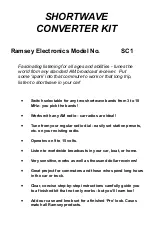
AS5045 12-BIT PROGRAMMABLE MAGNETIC ROTARY ENCODER
Adapter PCB Operation Manual
Revision A.02, 14-Mar-07 www.austriamicrosystems.com
Page 10 of 12
9.2
Reading the Adapter PCB with the AS5045 Demoboard Software:
Further information on the AS5045 Demoboard Software is available in the AS5045 Demoboard Operation Manual
(see: 7 Supporting Tools)
The AS5045 Adapter PCB can be read as “external encoder” in the same way as the internal encoder. Switching
from internal to external encoder can be done on the bottom left corner of the demoboard software screen :
Encoder = onboard / external. Additionally, when Encoder = external is selected, the buttons "Permanent write"
and "Read" are enabled in the "Zero Position" and "Incremental Mode" screens to allow OTP programming of the
external encoder
Changing the Zero Position:
The programming options zero position and ccw operation can be modified at any time during normal operation.
Permanently programming these registers will set the default setting after power-up. Programmed settings can
again be modified during normal operation but will be reset to default when the power supply is disconnected.
OTP programming of the external AS5045 encoder:
To program the external AS5045 encoder, a programming voltage of 7.5 to 8V DC (130mA) must be applied to
pins Vzapp and GND of the 3-pin connector at the right hand side of the demoboard. A 10µF buffer cap is
recommended for this voltage (see Figure 10).
Programming is not recommended with long wires between demoboard and external encoder, as the inductance
of the cable may generate high voltage spikes, that can cause wrong programming or even harm the IC. The
maximum wire length between the demoboard connector and the PROG pin of the external encoder should be
50mm (2”). Additionally, a 10nF ceramic capacitor should be connected close to pin PROG and VSS.
.
An OTP (one time programming) cycle is automatically initiated, when button "Permanent write" is pressed.
The default (non-programmed) logic state is "0" , consequently the programmed logic state is "1".
It is possible to write "1"s into the OTP register at subsequent programming cycles. However, a programmed "1"
cannot be cleared any more after programming.
Note that the chip will not be programmed, as long as no programming voltage is applied to Vzapp, although
the software will issue a warning message that the chip will be permanently programmed.
ams
AG
Technical
content
still
valid































